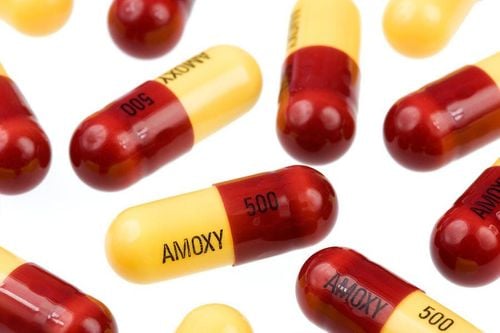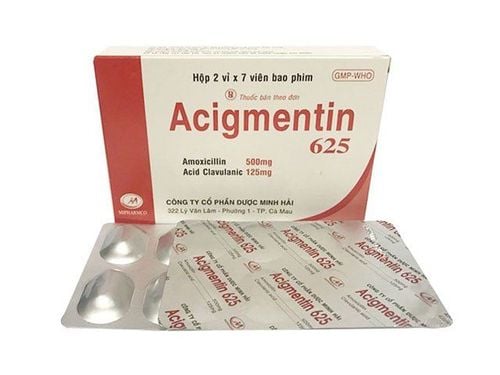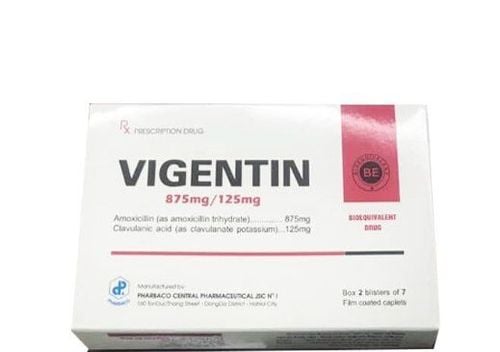This is an automatically translated article.
Tranfaximox drug is a drug to treat parasites, fight infections in the biliary tract, urinary tract, respiratory system. Has anti-viral, anti-fungal effects, the drug also supports the treatment of gonorrhea. How to use Tranfaximox effectively will be shared in detail in the article below.
1. What is Tranfaximox?
Tranfaximox medicine contains the main ingredients Amoxicillin, Clavulanic Acid. Has bactericidal effect, short-term treatment of severe infections in organs in the body.
Amoxicillin is an aminopenicillin, stable in acid medium, with a broader spectrum of activity than benzylpenicillin, especially against gram-negative bacilli. The drug has a bactericidal effect, by inhibiting the biosynthesis of mucopeptides of the bacterial cell wall. Amoxicillin is active against most gram-negative and gram-positive bacteria such as: Streptococcus, non-penicillinase-producing staphylococci, H. influenzae, Diplococcus pneumoniae, N.gonorrhoeae, E.coli, and proteus mirabilis.
Tranfaximox is stable in the acidic environment of gastric juice. Absorption is unaffected by food and is more rapid and complete than from the gastrointestinal tract.
Tranfaximox drug distributes rapidly into most body fluids, except brain tissue and cerebrospinal fluid, but when the meninges are inflamed, Amoxicillin diffuses easily. Approximately 60% of an oral dose of Tranfaximox is excreted unchanged in the urine within 6-8 hours.
2. Indications of the drug Tranfaximox
Severe upper respiratory tract infections: Tonsillitis, sinusitis, otitis media were treated with common antibiotics but did not improve. Lower respiratory tract infections by strains of H. influenzae and Branhamella catarrhalis producing beta - lactamase: Acute and chronic bronchitis, pneumonia - bronchiolitis. Severe infections of the urogenital tract by strains of E.coli, Klebsiella and Enterobacter: Cystitis, urethritis, pyelonephritis (female genital tract infection). Skin and soft tissue infections: boils, abscesses, wound infections. Bone and joint infections: Osteomyelitis. Dental infection: Alveolar abscess. Infections due to abortion, obstetric bacteremia, intra-abdominal infections (intravenous administration in bacteremia, peritonitis, postoperative infections, infection prevention during gastrointestinal surgery, uterus, head and neck, heart, kidney, joint replacement, and biliary tract).
3. Contraindications of the drug Tranfaximox
Allergy to beta-lactams (penicillins, and cephalosporins). Attention should be paid to the possibility of cross-allergenicity of Tranfaximox with beta-lactam antibiotics such as cephalosporins. Attention should be paid to patients with a history of jaundice/liver dysfunction caused by taking Amoxicillin and Clavulanate or Penicillins (because Clavulanic Acid increases the risk of intrahepatic cholestasis). Note:
For patients with manifestations of liver dysfunction: Signs and symptoms of cholestatic jaundice are rare with the drug but can be severe. For patients with moderate or severe renal impairment, attention should be paid to the dosage. In patients with a history of hypersensitivity to penicillins, severe reactions or death may occur.) For patients taking amoxicillin with redness accompanied by fever, lymphadenopathy. Prolonged use of Tranfaximox sometimes leads to the development of resistant bacteria. Should be avoided in pregnant women, especially in the first 3 months of pregnancy. During lactation can use the preparation. Tranfaximox is not harmful to a nursing infant unless there is a risk of sensitization due to the presence of very small amounts of the drug in breast milk.
4. Dosage and how to take Tranfaximox
4.1. How to take Tranfaximox Take Tranfaximox at the beginning of food to minimize the phenomenon of drug intolerance in the gastrointestinal tract. The dispersible tablet is stirred in a little water before taking it. In overdose, the drug is less likely to cause complications, because Tranfaximox is well tolerated even at high doses. In case of decreased renal function and poor blood-brain barrier, the injection will cause symptoms of toxicity. Tranfaximox dosage is usually expressed as the amount of Amoxicillin present in the drug. Amoxicillin and Clavulanate film coated tablets containing 250mg of Amoxicillin in a 2:1 ratio are different from those of a 4:1 ratio, so they are not interchangeable (For example, 2 250mg tablets are not equivalent to 1 500mg tablet; 1 250mg tablet not equivalent to one 250 mg chewable tablet). 4.2. Dosage of Tranfaximox Adults:
1 Tranfaximox 250mg tablet (containing 250mg amoxicillin and 125mg clavulanic acid) every 8 hours. For severe infections and respiratory tract infections: 1 Tranfaximox 500mg tablet (containing 500mg Amoxicillin and 125mg clavulanic acid) every 8 hours for 5 days. Children:
Children from 40kg or more, take Tranfaximox according to the adult dose. Children under 40 kg: Usual dose: 20 mg Amoxicillin/kg/day, divided into several doses 8 hours apart. For the treatment of otitis media, sinusitis, lower respiratory tract infections and severe infections, the usual dose: 40 mg Amoxicillin/kg/day in divided doses 8 hours apart, for 5 days. Children under 40 kg in weight should not take 250 mg film-coated tablets. Treatment with Tranfaximox should not exceed 14 days without re-examination. Patients with renal impairment:
If the creatinine clearance is greater than 30 ml/min: The dose does not need to be changed. If Creatinine clearance 15 - 30 ml/min: Usual dose given every 12-18 hours. If Creatinine clearance 5 - 15 ml/min: Usual dose given every 20 - 36 hours, Adults with creatinine clearance less than 5 ml/min: Give usual dose every 48 hours. On hemodialysis, give 1 500 mg tablet (containing 500 mg amoxicillin and 125 mg clavulanic acid) between each dialysis session and an additional 500 mg tablet after each dialysis. Peritoneal dialysis (peritoneal dialysis): 25 mg/kg every 24 hours; add 1 additional dose of 12.5 mg/kg, after dialysis; followed by 25 mg/kg/day.
5. Tranfaximox side effects
Common:
Diarrhea, nausea, vomiting. Skin: Rash, pruritus. Uncommon :
Blood: Eosinophilia. Gastrointestinal: Nausea, vomiting. Liver: Hepatitis and cholestatic jaundice, increased transaminases. Skin: Itching, erythema, rash. Rare:
Systemic: Anaphylactoid reactions, Quincke's edema. Blood: Mild thrombocytopenia, leukopenia, hemolytic anemia. Gastrointestinal: Pseudomembranous colitis. Skin: Stevens - Johnson syndrome, erythema multiforme, exfoliative dermatitis, toxic epidermal necrolysis. Kidney: Interstitial nephritis. Attention should be paid to elderly patients and adults, to prevent detection of cholestatic hepatitis.
Please dial HOTLINE for more information or register for an appointment HERE. Download MyVinmec app to make appointments faster and to manage your bookings easily.













